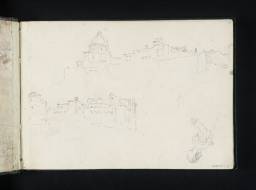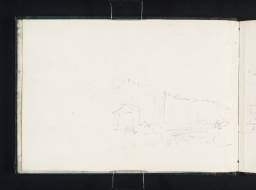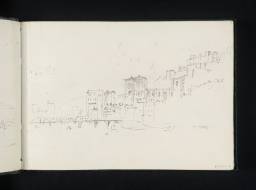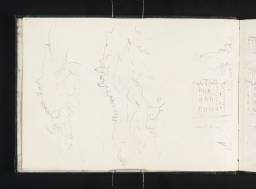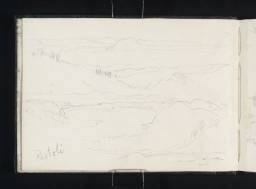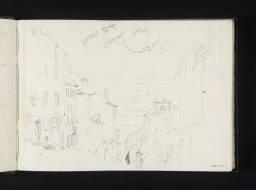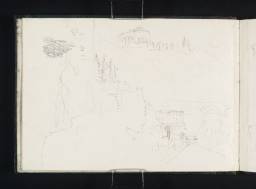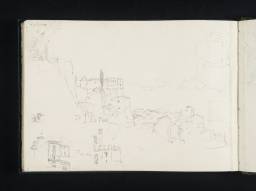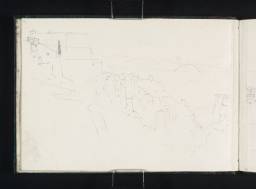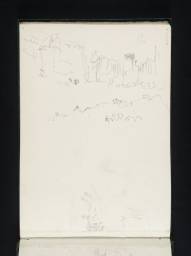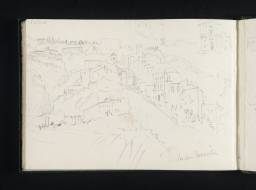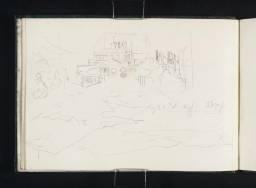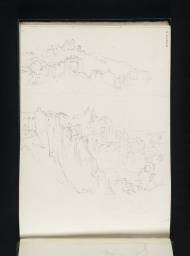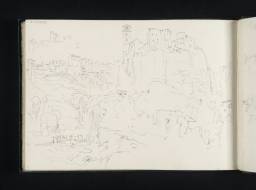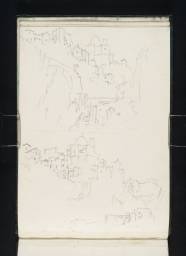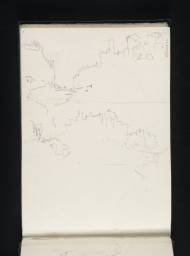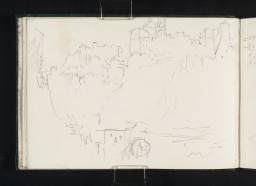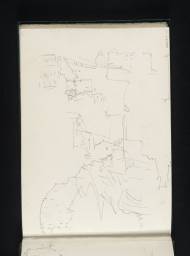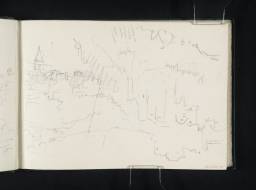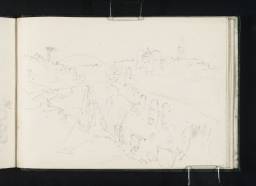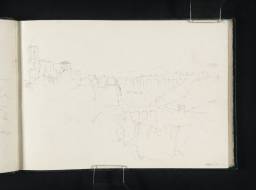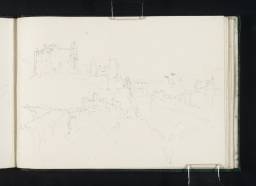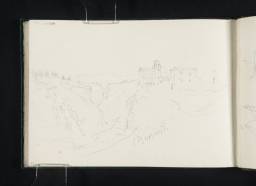Turner Bequest CCXXXVI 1–48a
Sketchbook bound in boards, covered in green cloth quarter-bound over brown leather spine
48 leaves and paste-downs of white wove paper; approximate page size 125 x 171 mm
Inscribed in ink and pencil by various hands inside front cover (D41121)
Numbered 173 as part of the Turner Schedule in 1854 and endorsed by the Executors of the Turner Bequest inside front cover (D41121)
48 leaves and paste-downs of white wove paper; approximate page size 125 x 171 mm
Inscribed in ink and pencil by various hands inside front cover (D41121)
Numbered 173 as part of the Turner Schedule in 1854 and endorsed by the Executors of the Turner Bequest inside front cover (D41121)
Accepted by the nation as part of the Turner Bequest 1856
Exhibition history
References
Turner used this sketchbook during his second major tour of France and Italy in 1828–9, as one of eight associated with this journey (see the overall tour Introduction). The fifth in the sequence, it is also the final book covering the outward leg of the tour to Rome. Continuing the itinerary of the preceding Florence to Orvieto sketchbook (Tate; Turner Bequest CCXXXIV), most of which falls within present-day Tuscany, here the trail begins south-west of Orvieto in Montefiascone. Covering around eighty miles of inland roads, Turner’s itinerary continues via Viterbo, Lago di Vico, Caprarola, Ronciglione, Nepi, and finally Rome. Most of these sites lie within the Viterbo province of Lazio, a region famed for its Etruscan heritage.
Finberg’s 1909 Inventory of the Bequest assigned generic titles to many of the works in this sketchbook, most of which have been updated in the present catalogue with greater geographical precision where possible.1 The author is especially indebted to the Turner scholars Cecilia Powell and Roland Courtot, whose research has greatly assisted this process.2 As Turner approached Rome, his route began to converge with the itinerary from his previous Italian tour of 1819–20, which also incorporated Nepi: see Nicola Moorby’s introduction to the Ancona to Rome sketchbook (Tate; Turner Bequest CLXXVII) in the present catalogue. The next sketchbook in the sequence is Rome to Rimini (Turner Bequest CLXXVIII), which covers the first part of Turner’s return journey to London.
The title Viterbo and Ronciglione, applied in Finberg’s 1909 Inventory of the Turner Bequest, is somewhat arbitrary.3 The sketchbook could more justifiably be called Nepi and Caprarola or Nepi and Montefiascone, given that Viterbo features in just a handful of sketches. Nepi, the subject of twenty-one works, is by some margin the most comprehensively examined location in the book. Turner studiously sketched its aqueduct, fortified castle, cathedral and town hall; for a list of relevant works, see under folio 12 verso (D21788). Turner was also captivated by the Palazzo Farnesi in Caprarola, a pentagonal fortress and Renaissance villa perched high on a hilltop overlooking the town. Intrigued by aspects of its design and construction, Turner sketched it from multiple vantage points: see under folio 4 verso (D21772) for a full list of views.
Other towns or cities to appear regularly in the sketchbook include Montefiascone (see under folio 1 recto; D21765); Ronciglione (folio 8 recto; D21779); Viterbo (folio 40 recto; D21834); and Rome (folio 23 recto; D21809). The volcanic topography of the Viterbo province also looms large; Turner closely observed the landscape around Lago di Vico, a lake situated on an ancient volcanic crater. From this region, he captured dramatic views of deep ravines and buildings perched precariously on volcanic promontories. Another defining feature of the landscape is distant Mont Soratte, a mountain range visible for much of Turner’s journey, and effectively an orientation point as he approached his destination Rome; for a full list of views, see under folio 27 verso (D21815).
Unlike the previous Florence to Orvieto sketchbook, the geographical itinerary covered by Viterbo and Ronciglione does not follow a logical progression. Among its inconsistencies are sketches of Montefiascone divided between the beginning and the end of the book, and views of Ronciglione and Nepi concentrated near the middle. Views of Rome fall part way through rather than at the end. Turner’s habitual sketching practices may account for this seemingly haphazard order. Eager to capture a view, he perhaps opened the book at random to fill the first available space he could find. A further explanation, acknowledged by Finberg in his 1909 Inventory of the Turner Bequest, concerns John Ruskin’s intervention.4 His dismantling of the sketchbook likely caused the pages to be incorrectly ordered when it was rebound at a later date. Finberg noted that the leaves of the book were ‘numbered and distributed’, with fifteen of them (folios 1, 11, 23, 24, 25, 26, 27, 30, 31, 34, 35, 36, 37, 38 and 39) contained in a separate parcel and labelled by Ruskin as ‘Inferior Leaves’.5
The most significant anomaly of Viterbo and Ronciglione, regarding its internal cohesion, is the appearance of the French city of Lyon (see folios 1 verso, 2 recto and 3 recto; D21766, D21767, D21769). Previously assigned the generic title Town, with River and Bridges in Finberg’s original itinerary, the identification of the views as Lyon is a recent discovery by Courtot.6 Chronologically, these depictions of Lyon are noteworthy as either the earliest or the latest sketches of Turner’s 1828–9 tour of France and Italy; it is unclear whether he sketched them on the outward or return leg of his journey.
Powell 1984 and 1987; Roland Courtot, ‘12. Vers Rome: “Carnet de Viterbe et Ronciglione” (TB CCXXXVI)’, Carnets de voyage de Turner, accessed 15 July 2024, https://carnetswt.hypotheses.org/2312 .
Technical notes
How to cite
Hannah Kaspar, ‘Viterbo and Ronciglione Sketchbook 1828–9’, sketchbook, December 2024, in David Blayney Brown (ed.), J.M.W. Turner: Sketchbooks, Drawings and Watercolours, Tate Research Publication, February 2025, https://www


